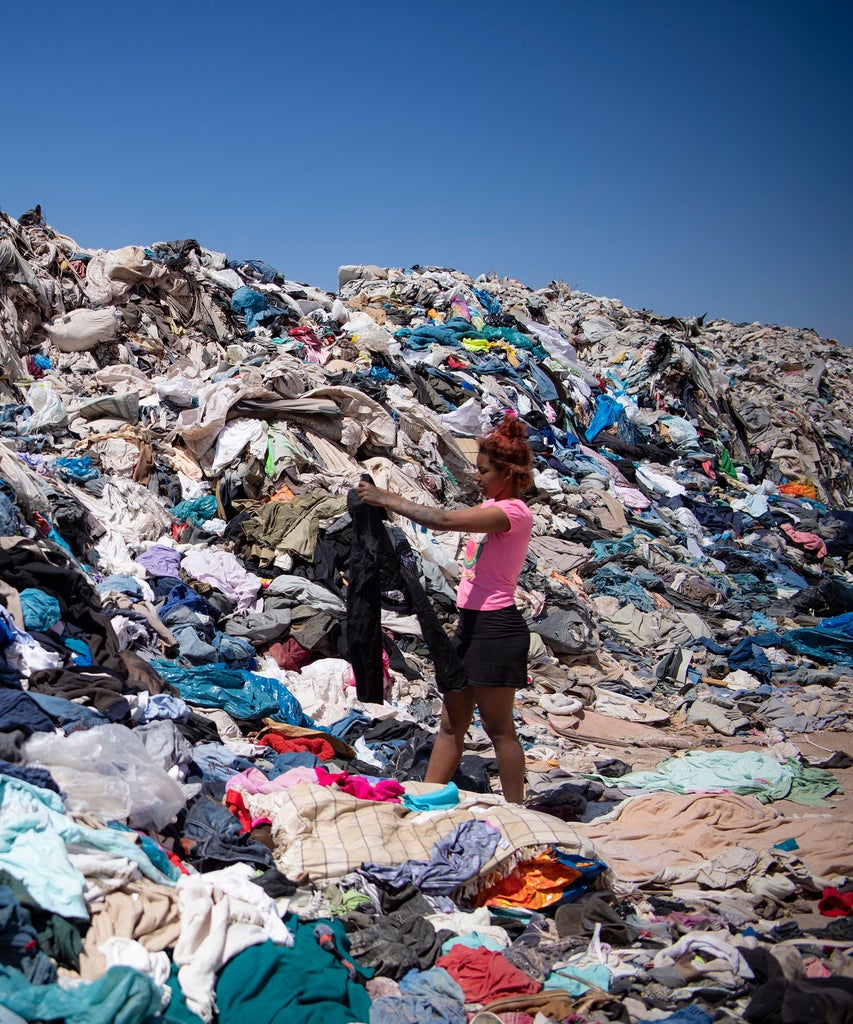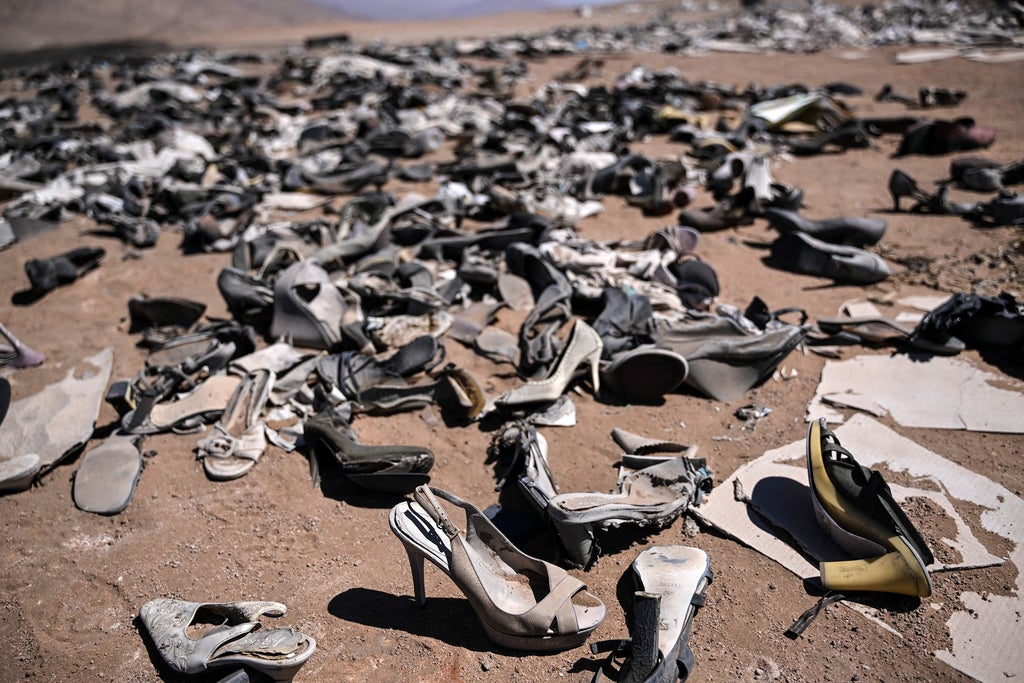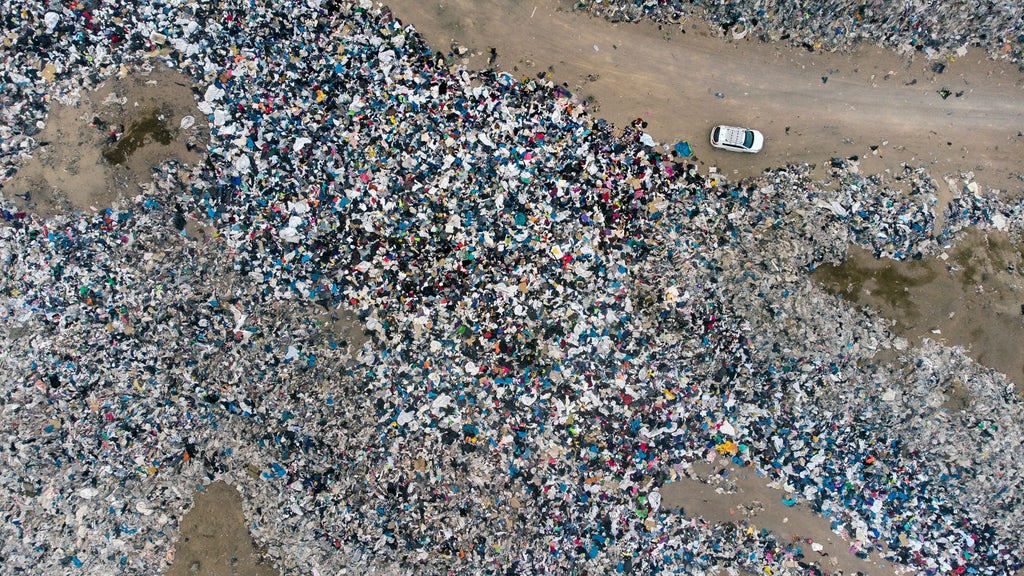
Tucked behind sand dunes throughout Chile’s Atacama Desert, heaps of branded jackets and hiking shoes that never found a second life were some of the most striking images that made their way around the world about a year ago. The “world’s dumpster,” as some international outlets came to call the estimated 741 deserted acres of clothing junkyards, had quietly taken shape in the planet’s most arid desert.
The hundreds of acres of amassed trash — countless articles of clothing, both torn and never worn — are collectively close to the size of New York’s Central Park. It was the product of more than a decade of clandestine clothing dumps hiding in plain sight. And since then, little seems to have changed from what started them.
“It gives everyone the impression that … there’s a certain inertia that prevents them [Chile’s government] from acting on this problem, which has been essentially an embarrassment for Chile worldwide,” Pamela Poo, a political scientist and director of Public Policy and Litigation at Fundación Ecosur, a Santiago-based environmental organization, tells Refinery29 Somos “This has been a story in every European country. And every follow-up regarding this issue leaves us looking really poorly as a society.”
Located in the north of Chile, the city of Iquique is home to one of the most important trading ports in South America and is close to where importers and their buyers converge daily in the tax-free commercial zone known as Zofri. Chile is the No. 1 importer of second-hand clothing in South America, according to trade data tracked by the Observatory of Economic Complexity. This is thanks to the lax regulations on importing second-hand clothing into Chile when compared to neighboring countries like Peru and Bolivia, which restrict importing low-quality textiles that have little chance of being resold.
“These are tons and tons of used clothing that ultimately end up in the desert, and the local governments don’t have the resources to take ownership of all this waste either.”
Pablo Oroz
Such are the effects of “fast fashion,” or the business of mass producing low-quality clothes quickly and at a low cost to keep up with trends.
The volume of clothes that arrive to Zofri mainly from the U.S., Europe, and Asia is so unmanageable, and the quality is often so low, that importers have no real gain from selling most of the product they bring in. Instead, they rely on locals willing to dump it somewhere the government won’t find it. More than half of the clothes that are imported to Chile annually end up in the Atacama Desert, the BBC reported in 2022.
“These are tons and tons of used clothing that ultimately end up in the desert, and the local governments don’t have the resources to take ownership of all this waste either,” Pablo Oroz, an environmental engineer with Arturo Prat University in Iquique, tells Somos.
According to the United Nations, the fashion industry is one of the world’s greatest polluters, responsible for about 20% of the planet’s waste water and about 10% of the world’s greenhouse gas emission.
Still, the problem of clandestine dumps, however public it has become, has continued to affect the communities living closest to them. Near Iquique, some residents of Alto Hospicio — a city of 108,000 people surrounded by desert dunes — live close to the textile dumps, as well as other junkyards full of cars, torn wheels, and everyday waste.

“Alto Hospicio is the fastest-growing city in the country,” says Oroz, who worked with the Alto Hospicio government until 2022. “That growth is of people who are highly vulnerable, people with very low economic resources, and a large number of migrants.”
For Poo, the political scientist with Fundación Ecosur, that reality is by design. In March 2022, her organization joined Paulin Silva Heredia, an environmental lawyer, and other organizations in a high-profile lawsuit against the Chile government, Alto Hospicio, and Iquique over the textile waste.
Silva Heredia, whose family owns a home just a few miles from the location of one of the biggest dumps, accused government officials of “inaction and negligence” as clothes accumulated in the desert, something she said was known by residents of Alto Hospicio since 2012. The textile dumps, Silva Heredia alleged in the initial complaint, “have generated for years, and continue to generate currently, grave damages to the environment of an enormous magnitude and that are prone to becoming irreparable.”
The lawsuit, filed in Chile’s environmental court system, has not yet been resolved.
“Alto Hospicio is the fastest-growing city in the country. That growth is of people who are highly vulnerable, people with very low economic resources, and a large number of migrants.”
Pablo Oroz
“What shocks me the most is like, how did no one see this,” Poo asks. “Where are the authorities?”
Among Silva Heredia’s claims is that the residents of Alto Hospicio have for years also had to put up with fires set intentionally at the dump sites, which could take several days to put out. The most recent fire was reported in June 2022, when 100,000 tons of clothes were burnt. According to Desierto Vestido, a community-based environmental organization in Alto Hospicio, it took about 15 days to extinguish the blaze.
Burning clothes releases toxic gasses, as most textiles are made of polyester, a synthetic fiber made with petroleum.
“People have no idea that when they see a tag that reads ‘polyester,’ in the end you are putting on a piece of petroleum,” says Poo, whose organization also works to educate Chileans on how to buy clothes more sustainably.
Curbing the estimated 60,000 tons of clothes imported yearly into Chile requires changing the laws. Environmental advocates like Poo have called for years a law that places responsibility of environmental impact partly on producers. While general waste items are included in the language of the law, it does not include textiles.

“It’s merchandise that ultimately cannot be limited through trade because it’s a consumer good, it’s not characterized as waste,” says Oroz, the environmental engineer, adding that bureaucracy also made it difficult for Alto Hospicio to use public funds to address the issue.
In 2021, Chile’s environment minister at the time pledged to include textiles in the law. But no movement has been made on the issue since then, Oroz and Poo agree. Oroz, who now works in the private sector, adds that it would likely take “several years” to amend the law.
“I think people are just used to the idea that there are second-class Chilean citizens. And that’s really outrageous that people are coming at it from that perspective.”
Pamela Poo
“The ones who benefit in the end are the business owners at Zofri who import used clothing, since the cheapest option for them to get rid of the waste is to practically gift it to low-income people so they solve the problem for them,” he says. Though, Oroz acknowledges, that is not a long-term solution.
What has emerged as a short-term fix are companies from Chile and beyond that have seen an opportunity to profit from repurposing the excess textile waste. Ecofibra Chile was one of the first companies that made alliances with people transporting waste to the Atacama Desert to repurpose it. With the waste, they made thermal insulation panels that can be used in construction, mining, and other industries.
But the current efforts are not enough to keep the situation from repeating itself, advocates say.
“The truth is I notice the population sort of accepts that these things happen,” says Poo. “There’s no concerted calls or major complaints about it, but rather I think people are just used to the idea that there are second-class Chilean citizens. And that’s really outrageous that people are coming at it from that perspective.”
Like what you see? How about some more R29 goodness, right here?
from Refinery29 https://ift.tt/wq0WQRO
via IFTTT
